Suranga Nanayakkara
EmoSign: A Multimodal Dataset for Understanding Emotions in American Sign Language
May 20, 2025Abstract:Unlike spoken languages where the use of prosodic features to convey emotion is well studied, indicators of emotion in sign language remain poorly understood, creating communication barriers in critical settings. Sign languages present unique challenges as facial expressions and hand movements simultaneously serve both grammatical and emotional functions. To address this gap, we introduce EmoSign, the first sign video dataset containing sentiment and emotion labels for 200 American Sign Language (ASL) videos. We also collect open-ended descriptions of emotion cues. Annotations were done by 3 Deaf ASL signers with professional interpretation experience. Alongside the annotations, we include baseline models for sentiment and emotion classification. This dataset not only addresses a critical gap in existing sign language research but also establishes a new benchmark for understanding model capabilities in multimodal emotion recognition for sign languages. The dataset is made available at https://huggingface.co/datasets/catfang/emosign.
Navigating the State of Cognitive Flow: Context-Aware AI Interventions for Effective Reasoning Support
Apr 22, 2025Abstract:Flow theory describes an optimal cognitive state where individuals experience deep focus and intrinsic motivation when a task's difficulty aligns with their skill level. In AI-augmented reasoning, interventions that disrupt the state of cognitive flow can hinder rather than enhance decision-making. This paper proposes a context-aware cognitive augmentation framework that adapts interventions based on three key contextual factors: type, timing, and scale. By leveraging multimodal behavioral cues (e.g., gaze behavior, typing hesitation, interaction speed), AI can dynamically adjust cognitive support to maintain or restore flow. We introduce the concept of cognitive flow, an extension of flow theory in AI-augmented reasoning, where interventions are personalized, adaptive, and minimally intrusive. By shifting from static interventions to context-aware augmentation, our approach ensures that AI systems support deep engagement in complex decision-making and reasoning without disrupting cognitive immersion.
* Presented at the 2025 ACM Workshop on Human-AI Interaction for Augmented Reasoning, Report Number: CHI25-WS-AUGMENTED-REASONING
MorphFader: Enabling Fine-grained Controllable Morphing with Text-to-Audio Models
Aug 14, 2024Abstract:Sound morphing is the process of gradually and smoothly transforming one sound into another to generate novel and perceptually hybrid sounds that simultaneously resemble both. Recently, diffusion-based text-to-audio models have produced high-quality sounds using text prompts. However, granularly controlling the semantics of the sound, which is necessary for morphing, can be challenging using text. In this paper, we propose \textit{MorphFader}, a controllable method for morphing sounds generated by disparate prompts using text-to-audio models. By intercepting and interpolating the components of the cross-attention layers within the diffusion process, we can create smooth morphs between sounds generated by different text prompts. Using both objective metrics and perceptual listening tests, we demonstrate the ability of our method to granularly control the semantics in the sound and generate smooth morphs.
EMO-KNOW: A Large Scale Dataset on Emotion and Emotion-cause
Jun 18, 2024Abstract:Emotion-Cause analysis has attracted the attention of researchers in recent years. However, most existing datasets are limited in size and number of emotion categories. They often focus on extracting parts of the document that contain the emotion cause and fail to provide more abstractive, generalizable root cause. To bridge this gap, we introduce a large-scale dataset of emotion causes, derived from 9.8 million cleaned tweets over 15 years. We describe our curation process, which includes a comprehensive pipeline for data gathering, cleaning, labeling, and validation, ensuring the dataset's reliability and richness. We extract emotion labels and provide abstractive summarization of the events causing emotions. The final dataset comprises over 700,000 tweets with corresponding emotion-cause pairs spanning 48 emotion classes, validated by human evaluators. The novelty of our dataset stems from its broad spectrum of emotion classes and the abstractive emotion cause that facilitates the development of an emotion-cause knowledge graph for nuanced reasoning. Our dataset will enable the design of emotion-aware systems that account for the diverse emotional responses of different people for the same event.
* Accepted to Findings of EMNLP 2023
Example-Based Framework for Perceptually Guided Audio Texture Generation
Aug 23, 2023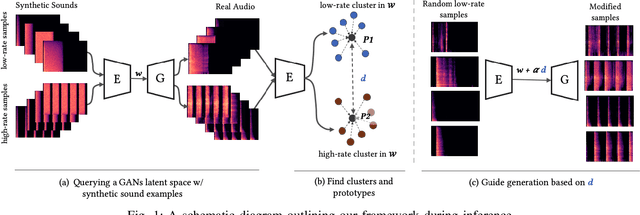
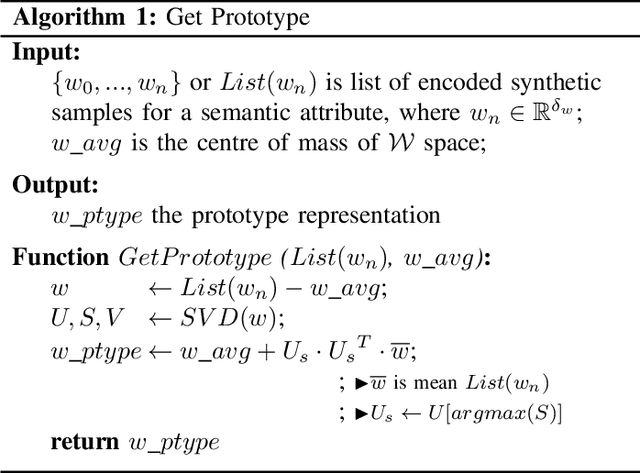

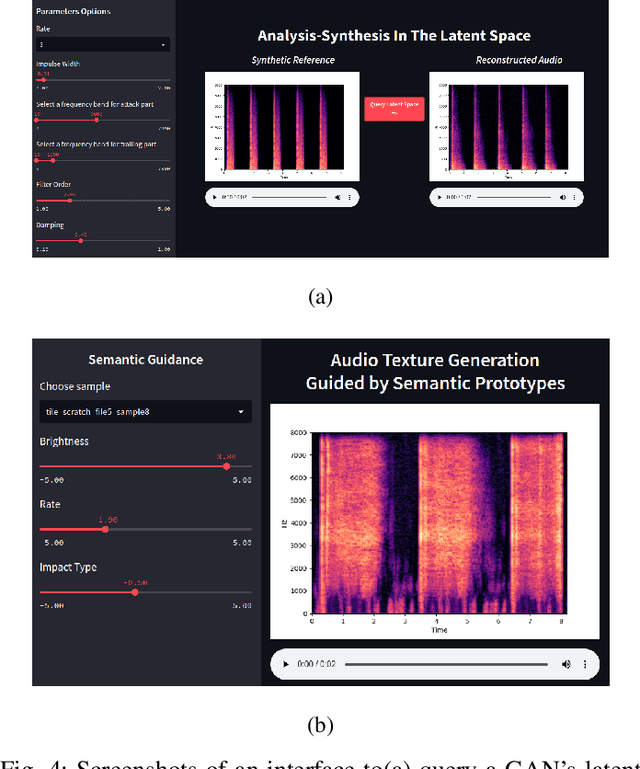
Abstract:Generative models for synthesizing audio textures explicitly encode controllability by conditioning the model with labelled data. While datasets for audio textures can be easily recorded in-the-wild, semantically labeling them is expensive, time-consuming, and prone to errors due to human annotator subjectivity. Thus, to control generation, there is a need to automatically infer user-defined perceptual factors of variation in the latent space of a generative model while modelling unlabeled textures. In this paper, we propose an example-based framework to determine vectors to guide texture generation based on user-defined semantic attributes. By synthesizing a few synthetic examples to indicate the presence or absence of a semantic attribute, we can infer the guidance vectors in the latent space of a generative model to control that attribute during generation. Our results show that our method is capable of finding perceptually relevant and deterministic guidance vectors for controllable generation for both discrete as well as continuous textures. Furthermore, we demonstrate the application of this method to other tasks such as selective semantic attribute transfer.
VR.net: A Real-world Dataset for Virtual Reality Motion Sickness Research
Jun 06, 2023Abstract:Researchers have used machine learning approaches to identify motion sickness in VR experience. These approaches demand an accurately-labeled, real-world, and diverse dataset for high accuracy and generalizability. As a starting point to address this need, we introduce `VR.net', a dataset offering approximately 12-hour gameplay videos from ten real-world games in 10 diverse genres. For each video frame, a rich set of motion sickness-related labels, such as camera/object movement, depth field, and motion flow, are accurately assigned. Building such a dataset is challenging since manual labeling would require an infeasible amount of time. Instead, we utilize a tool to automatically and precisely extract ground truth data from 3D engines' rendering pipelines without accessing VR games' source code. We illustrate the utility of VR.net through several applications, such as risk factor detection and sickness level prediction. We continuously expand VR.net and envision its next version offering 10X more data than the current form. We believe that the scale, accuracy, and diversity of VR.net can offer unparalleled opportunities for VR motion sickness research and beyond.
Towards Controllable Audio Texture Morphing
Apr 23, 2023Abstract:In this paper, we propose a data-driven approach to train a Generative Adversarial Network (GAN) conditioned on "soft-labels" distilled from the penultimate layer of an audio classifier trained on a target set of audio texture classes. We demonstrate that interpolation between such conditions or control vectors provides smooth morphing between the generated audio textures, and shows similar or better audio texture morphing capability compared to the state-of-the-art methods. The proposed approach results in a well-organized latent space that generates novel audio outputs while remaining consistent with the semantics of the conditioning parameters. This is a step towards a general data-driven approach to designing generative audio models with customized controls capable of traversing out-of-distribution regions for novel sound synthesis.
Improving the Domain Adaptation of Retrieval Augmented Generation (RAG) Models for Open Domain Question Answering
Oct 06, 2022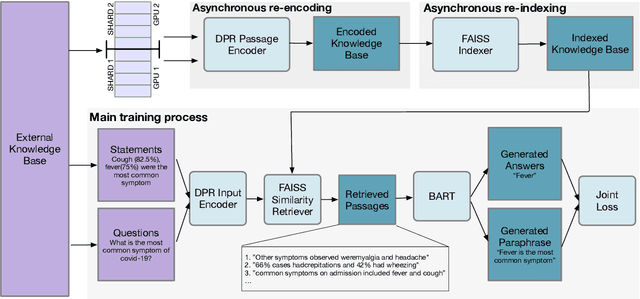
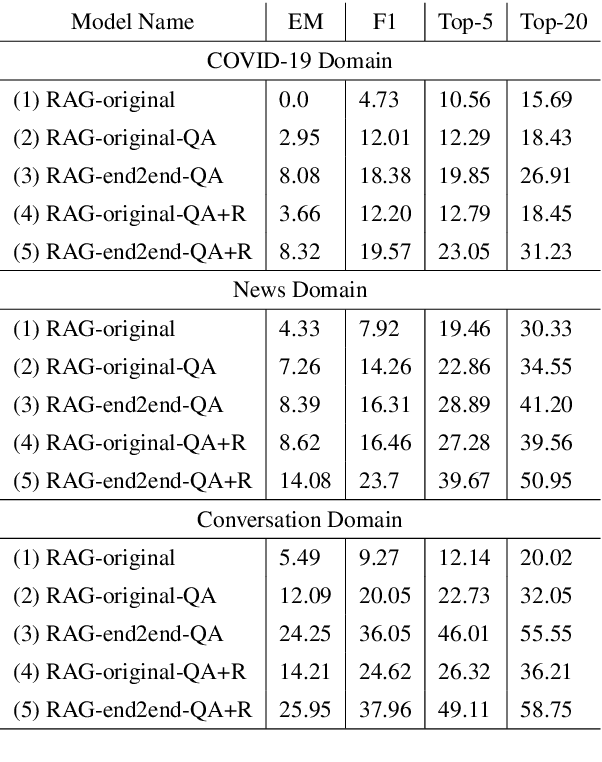
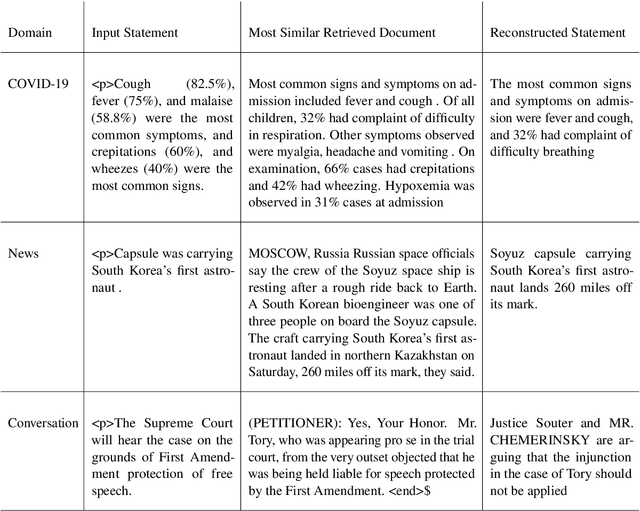
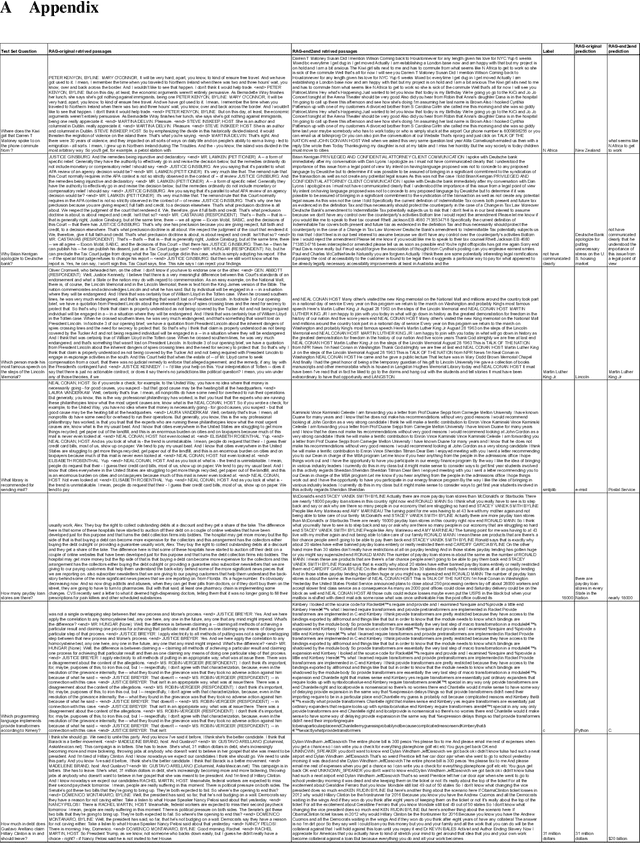
Abstract:Retrieval Augment Generation (RAG) is a recent advancement in Open-Domain Question Answering (ODQA). RAG has only been trained and explored with a Wikipedia-based external knowledge base and is not optimized for use in other specialized domains such as healthcare and news. In this paper, we evaluate the impact of joint training of the retriever and generator components of RAG for the task of domain adaptation in ODQA. We propose \textit{RAG-end2end}, an extension to RAG, that can adapt to a domain-specific knowledge base by updating all components of the external knowledge base during training. In addition, we introduce an auxiliary training signal to inject more domain-specific knowledge. This auxiliary signal forces \textit{RAG-end2end} to reconstruct a given sentence by accessing the relevant information from the external knowledge base. Our novel contribution is unlike RAG, RAG-end2end does joint training of the retriever and generator for the end QA task and domain adaptation. We evaluate our approach with datasets from three domains: COVID-19, News, and Conversations, and achieve significant performance improvements compared to the original RAG model. Our work has been open-sourced through the Huggingface Transformers library, attesting to our work's credibility and technical consistency.
Fine-tune the Entire RAG Architecture for Question-Answering
Jun 22, 2021Abstract:In this paper, we illustrate how to fine-tune the entire Retrieval Augment Generation (RAG) architecture in an end-to-end manner. We highlighted the main engineering challenges that needed to be addressed to achieve this objective. We also compare how end-to-end RAG architecture outperforms the original RAG architecture for the task of question answering. We have open-sourced our implementation in the HuggingFace Transformers library.
Jointly Fine-Tuning "BERT-like" Self Supervised Models to Improve Multimodal Speech Emotion Recognition
Aug 15, 2020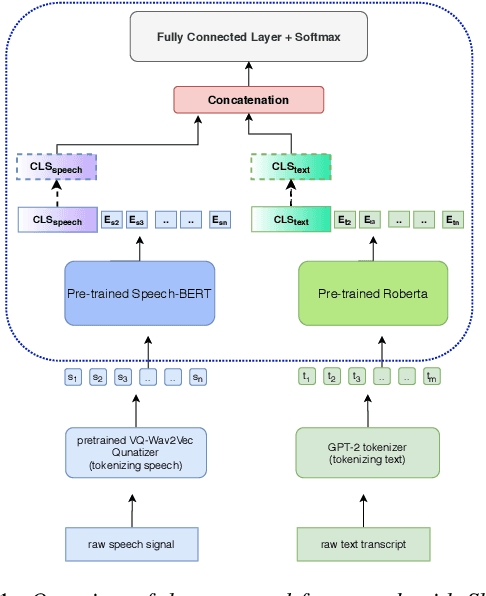
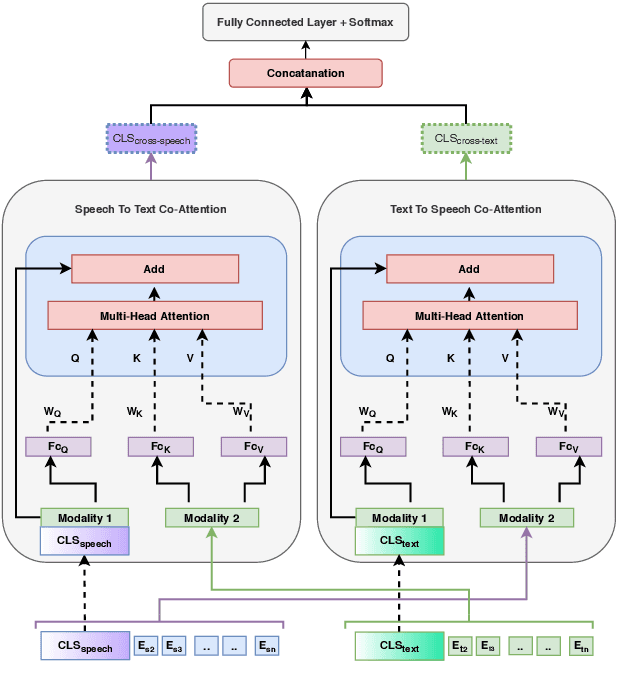
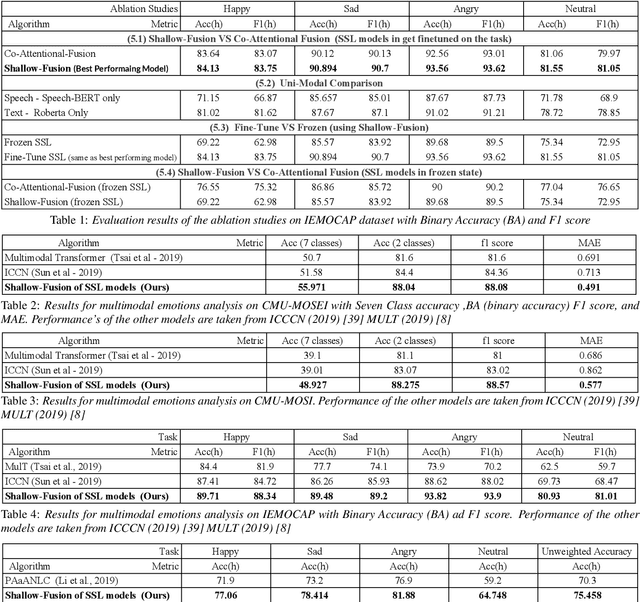
Abstract:Multimodal emotion recognition from speech is an important area in affective computing. Fusing multiple data modalities and learning representations with limited amounts of labeled data is a challenging task. In this paper, we explore the use of modality-specific "BERT-like" pretrained Self Supervised Learning (SSL) architectures to represent both speech and text modalities for the task of multimodal speech emotion recognition. By conducting experiments on three publicly available datasets (IEMOCAP, CMU-MOSEI, and CMU-MOSI), we show that jointly fine-tuning "BERT-like" SSL architectures achieve state-of-the-art (SOTA) results. We also evaluate two methods of fusing speech and text modalities and show that a simple fusion mechanism can outperform more complex ones when using SSL models that have similar architectural properties to BERT.
 Add to Chrome
Add to Chrome Add to Firefox
Add to Firefox Add to Edge
Add to Edge